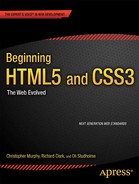Forewords
HTML5. It’s the most significant web spec today, and the first upgrade of the Web’s ubiquitous language in a decade. Together with its cousin CSS 3, it’s very powerful,very exciting and ludicrously over-hyped. Some “experts” will tell you that you can only use HTML5/ CSS 3 in the bleeding-edge nightly build of their favourite browser. Other pundits will tell you that you can’t use them because “the specs aren’t finished”, or there is no support in Internet Explorer, or other such blahblahblah.
When you’re trying to learn you need trustworthy teachers who are neither pedantic zealots or flatulent marketeers. You need people like Rich, Oli, Chris and Divya.
Richard Clark is a fellow HTML5 Doctor, curator of HTML5 gallery and, crucially, is a man who builds things. Oli Studholme is also a fellow HTML5 Doctor and developer working in the trenches, only these trenches are in his adopted homeland of Japan. Chris is Subject Director of Interactive Multimedia Design, at the University of ulster - one of the few universities in the world that teaches modern web design that employers actually need graduates to know. Divya is one of the team behind HTML5 Boilerplate and an Adobe representative on the CSS Working Group.
Bruce Lawson
Co-author Introducing HTML5 (New Riders), Open Web Evangelist, Opera Software
It’s hard to believe it, but there was a time when CSS was considered a dying technology. Riven by incomplete and (worse) incompatible implementations, mired by a legacy not of its own making, it seemed destined to join the towering scrap-heap of interesting-yet-failed technologies-and now, thanks to some lucky breaks and hard work, here it is, a fundamental aspect of the web. Indeed, it has spread far beyond the web, showing up as the display mechanism in software as diverse chat clients and operating systems. If it is less critical to our modern networks than HTML, it cannot be by much.
Even more exciting, after a relatively quiet period, CSS is being rapidly expanded and enriched on multiple fronts. Ideas from frameworks and libraries are being merged into the official specifications. Long-standing proposals are gaining monentum. Ancient omissions are being addressed. All in all, there’s so much happening that it could be an expert’s full-time job keeping track of it all.
Fortunately, what you have here in your hands is the product of several experts’ combined knowledge, skills, and insight. Chris, Divya, Oli, and Rich are all veterans at navigating the sometimes dense language of W3C specifications to extract the shining jewels found within. Furthermore, they excel at taking those rough diamonds and polishing them to brilliant examples of how and why a feature should be used. If I were starting out, I could hardly wish for better guides to understanding what’s important and interesting in CSS today-and as the old, grizzled codger I actully am, I look to them forclues regarding where I should or shouldn’t be looking, in order to stay abreast of everything that’s happening.
CSS is experiencing nothing short of a Renaissance. Enjoy learning from these four masters of its art.
Eric A. Meyer
Author, ’CSS: The Definitive Guide’ (O’Reilly); Co-founder, An Event Apart
